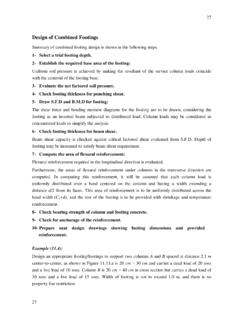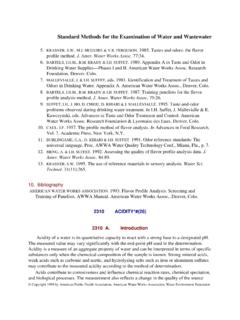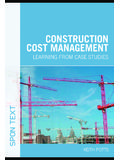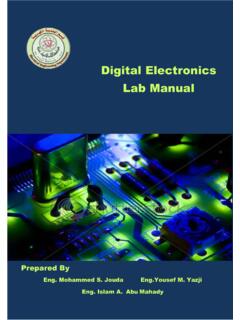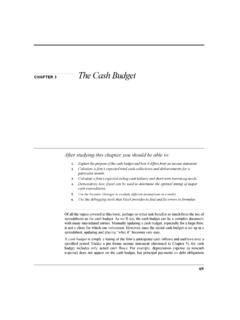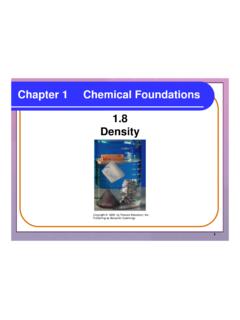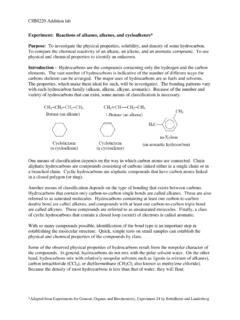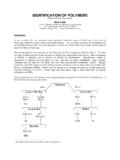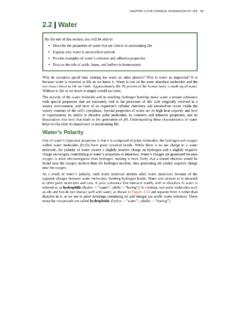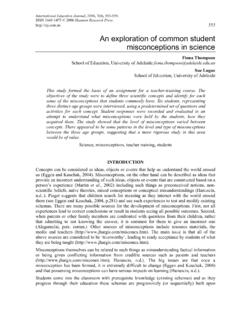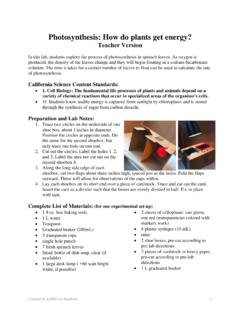Transcription of Chapter 10 Fundamentals of Metal Casting
1 1 Chapter 10 Fundamentals of Metal Casting IInnttrroodduuccttiioonn One of the oldest processes used to shape metals is the Casting process (CP) which basically involves: 1. Pouring molten Metal into a mold cavity (patterned after the part to be mfg), 2. Allowing it to solidify (cool), and 3. Removing the part from the mold. Casting processes developed over the years can be classified into: 1. Expandable mold: sand, shell, expandable pattern, plaster, ceramic and investment. 2. Permanent mold: slush, pressure, die, centrifugal, squeeze, and semisolid.
2 3. Single crystal growing: single crystals for microelectronics, single-crystal turbine blades, and directional solidification. As in all manufacturing, each Casting process has its own characteristics, applications, advantages limitations, and costs. Casting processes are most often selected over other manufacturing methods, for the following reasons: 1. Casting can produce complex shapes with internal cavities or hollow sections. 2. Very large parts can be produced in one piece. 3. It can utilize materials that are difficult or uneconomical to process by other means.
3 4. Casting is competitive with other processes. Almost all metals can be cast in the final shape desired (net-shape mfg), often with only minor finishing operations required. Important considerations in Casting operations: 1. Flow of the molten Metal into the mold cavity. 2. Solidification and cooling of the Metal in the mold. 3. The influence of the type of mold material. Metal Fundamentals are discussed in this Chapter . Industrial Metal -processes, design considerations and Casting materials are described in Chapter 11 and 12.
4 The Casting of ceramics and plastics are discussed in chapters 18 and 19, respectively. SSoolliiddiiffiiccaattiioonn ooff MMeettaallss After pouring molten Metal into a mold, a series of events takes place during the solidification of the Metal and cooling to room temperature. These events greatly influence the size, shape uniformity, and chemical composition of the grains formed throughout the Casting , which in turn influence its over all properties. SSoolliiddiiffiiccaattiioonn ooff PPuurree MMeettaallss A pure Metal solidifies at a constant temperature.
5 It has a clearly defined melting (or freezing) point (see table and fig. ). After the temperature of the molten Metal drops to its freezing point, its temperature remains constant while the latent heat of fusion is given off. The solidification front (solid-liquid interface) moves through the molten Metal , solidifying from the mold walls in toward the center. 2 Figure (a) Temperature as a function of time for the solidification of pure metals. Note that the freezing takes place at a constant temperature. (b) density as a function of time 3 The grain structure of a pure Metal cast in a square mold is shown in Fig : 9 At the mold walls (usually at room temp), the Metal cools rapidly and produces a solidified skin (or shell) of fine equiaxed grains (approx.)
6 Equal dims. in all dirs.) 9 The grains grow in a direction opposite to that of the heat transfer out through the mold. Those grains that have favorable orientations grow preferentially away from the surface of the mold producing columnar grains (Fig. ). 9 As the driving force of the heat transfer is reduced away from the mold walls, the grains become equiaxed and coarse. Those grains that have substantially different orientations are blocked from further growth. Such grains development is known as homogeneous nucleation, meaning that the grains grow upon themselves, starting at the mold wall.
7 Figure Schematic illustration of three cast structures of metals solidified in a square mold: (a) pure metals; (b) solid-solution alloys; and (c) structure obtained by using nucleating agents. Figure Development of a preferred texture at a cool mold wall. Note that only favorably oriented grains grow away from the surface of the mold 4 When the heat is abstracted rapidly, however, solidification it leads to fine structures due to a decrease in diffusion rates. SSoolliiddiiffiiccaattiioonn ooff AAllllooyyss Solidification begins when the temperature drops below the liquidus, TL, and is complete when it reaches the solidus, TS ( ).
8 Within this temperature range, the alloy is in a mushy or pasty state with columnar dendrites (close to tree). Note the liquid Metal present between the dendrite arms. Figure Schematic illustration of alloy solidification and temperature distribution in the solidifying Metal . Note the formation of dendrites in the mushy zone. Dendrites have 3-D arms and branches (secondary arms) which eventually interlock, as can be seen in Fig. Figure (a) Solidification patterns for gray cast iron in a 180-mm square Casting . Note that after 11 minutes of cooling, dendrites reach each other, but the Casting is still mushy throughout.
9 It takes about two hours for this Casting to solidify completely. (b) Solidification of carbon steels in sand and chill ( Metal ) molds. Note the difference in solidification patterns as the carbon content increases. The width of the mushy zone (L & S) is an important factor during solidification. It is described by the freezing range as: 5 Freezing range = TL - TS ( ) It can be seen in Figure that pure metals have no freezing range, and that the solidification front moves as a plane front without forming a mushy zone. In alloys with a nearly symmetrical phase diagram, the structure is generally lamellar, with two or more solid phases present, depending on the alloy system.
10 When the volume fraction of the minor phase of the alloy is less than about 25%, the structure generally becomes fibrous. These conditions are particularly important for cast irons. For alloys, a short freezing range generally involves a temperature difference < 50o C, and a long freezing range > 110o C. Ferrous castings generally have narrow mushy zones, whereas aluminum and magnesium alloys have wide mushy zones. EEffffeeccttss ooff ccoooolliinngg rraatteess Slow cooling rates (order of 102 K/s) long solidification time- result in coarse dendritic structures with large spacing between the dendrite arms.
